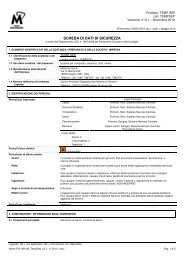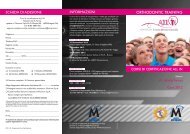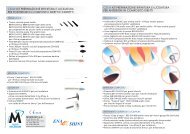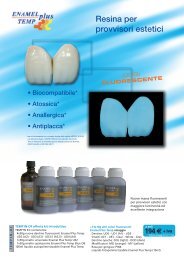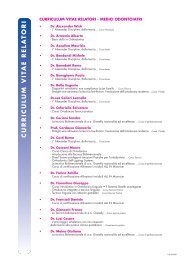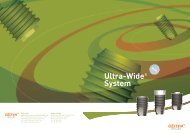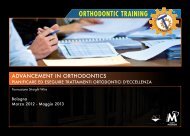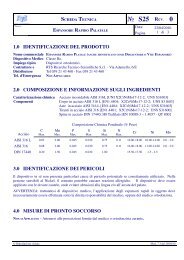You also want an ePaper? Increase the reach of your titles
YUMPU automatically turns print PDFs into web optimized ePapers that Google loves.
Edition 09 / 2009Taper<strong>Implant</strong> System(<strong>GS</strong> <strong>III</strong> <strong>Implant</strong> & SS <strong>III</strong> <strong>Implant</strong>)Catalog & ManualTaper<strong>Implant</strong> System(<strong>GS</strong> <strong>III</strong> <strong>Implant</strong> & SS <strong>III</strong> <strong>Implant</strong>)Catalog & ManualHead office8th FL. WorldMeridian Venture CenterⅡ, 426-5,Gasan-dong, Geumcheon-gu, Seoul, Koreatel_ 82 2 2016 7000, fax_ 82 2 2016 7001homepage_ http://www.osstem.comManufacturer#507-8, Geoje3-dong, Yeonje-guBusan, Korea. Zip_ 611-804tel_ 82 51 850 2500fax_ 82 51 861 4693<strong>GS</strong> <strong>III</strong> <strong>Implant</strong> & SS <strong>III</strong> <strong>Implant</strong>
Taper<strong>Implant</strong> System(<strong>GS</strong> <strong>III</strong> <strong>Implant</strong> & SS <strong>III</strong> <strong>Implant</strong>)Catalog & ManualContents1 Taper <strong>Implant</strong> Features2 <strong>GS</strong> <strong>III</strong> <strong>Implant</strong> Specifications3 SS <strong>III</strong> <strong>Implant</strong> Specifications4 Surgical Procedure & KIT - Taper & Straight5 Clinical Indications & Case6 Cautions - Drilling & <strong>Implant</strong>ation, KIT<strong>GS</strong> <strong>III</strong> <strong>Implant</strong> & SS <strong>III</strong> <strong>Implant</strong>
Taper <strong>Implant</strong> FeaturesTaper <strong>Implant</strong> FeaturesTaper <strong>Implant</strong> FeaturesTaper <strong>Implant</strong> Features<strong>GS</strong>/SS <strong>III</strong> implants are designs based on accumulated research anddevelopment by Osstem <strong>Implant</strong> Co., Ltd. Superior initial stability,insertion feel and surgical convenience are some of the featuresengineered into these implants.Experiencesecure initial stability for immediate & early loadingeffortless fixture implantationconvenient implant surgery<strong>GS</strong> <strong>III</strong> <strong>Implant</strong>SS <strong>III</strong> <strong>Implant</strong>Micro Thread0.4p x 0.25d x fourfold threaddistributes bone stressstimulates bone evenlyincreased cell responsereinforces fixture strengthCorkscrew Thread0.8p x 0.5d x double threadpowerful self threadingchange path easilyincreases insertion torque in soft boneincreased initial stability in soft bonedecrease dependency on drill sizeGingival Height Smooth surface for soft tissue Regular Platform ; 1.8/2.8Wide Platform ; 2.0Micro Thread Sufficient torque ability for final insertionThread & Cutting Edge 0.8p x 0.5d x double thread Powerful self threading Helix-shaped cutting edgeApex Self drilling ability Higher initial stability in fresh extracted sockets04 Taper <strong>Implant</strong> System Catalog & Manual<strong>GS</strong> <strong>III</strong> <strong>Implant</strong> & SS <strong>III</strong> <strong>Implant</strong>05
Taper <strong>Implant</strong> FeaturesTaper <strong>Implant</strong> FeaturesSecure initial stability for immediate & early loadingSecure initial stability for immediate & early loadingSuccessful immediate and early loading is dependent on a fixture having sufficient and secure initial stability.<strong>GS</strong>/SS <strong>III</strong> fixture designs are optimal for immediate and early loading, they have been evaluated for initial stabilityvia rigorous testing of insertion torque, RFA, push-pull indices. Results show <strong>GS</strong>/SS <strong>III</strong> have the necessaryfeatures that will guarantee successful immediate and early loading procedures.Optimal design for immediate and early loadingMicrothread: Microthreads of the fixture maximizes contactMicro Threadbetween the fixture and D3 bone with a thin cortical layer.Tapered body: <strong>GS</strong>/SS <strong>III</strong> fixtures have a 1.5 tapered body whichallows for an appropriate amount of insertion torque for a smoothTapered Body 1.5transition into the bone. This taper angle was determined bylooking for the lowest interference between drilling hole andfixture and insertion torque pattern.Screw thread (number & depth): <strong>GS</strong>/SS <strong>III</strong> fixtures have fourfoldCorkscrew Threadthreads on the upper portion and double threads on the lower,this configuration enables quick insertions and secureattachment to the bone. The lower portion has a thread depth of0.5mm, this prevents excessive torque but provides anappropriate amount even when using a small drill.Insertion TorqueInsertion torque lets the operator determine the quality of initialstability and serves as an index for deciding on immediate &early loading. Generally, insertion torque of 30 - 40 Ncm isacceptable for immediate loading.<strong>GS</strong>/SS <strong>III</strong> fixtures and it's surgical procedures are specificallydesigned for insertions using over 30 Ncm even in soft bone (D3).Following the <strong>GS</strong>/SS <strong>III</strong> placement procedures will result insufficient initial stability for immediate and early loading (exceptin cases where bone quality or bone volume is poor).RFA TestResonance Frequency Analysis (RFA) measures initial stability ofa fixture using resonance frequency; an accepted method ofobtaining objective data on initial stability.RFA testing will output an <strong>Implant</strong> Stability Quotient (ISQ) valueof the fixture's stability; the Osstell Mentor (Osstell AB) can beused to measure this very easily.ISQ values sufficient for immediate loading varies from literatureto literature, but generally a value of over 65 is consideredacceptable.Tests using the <strong>GS</strong>/SS <strong>III</strong> fixtures averaged an ISQ value of over65 in D3 bone. But note that short fixtures (7 to 8.5mm), had ISQvalues that were not acceptable, therefore immediate or earlyloading is not recommended.Push-pull testExternal forces acting upon a fixture'sstability can be evaluated using a pushpulltest.When push or pull forces are applied toPush-Pull Testan implanted fixture, a stable andsecure fixture will have minimaldisplacement.<strong>GS</strong>/SS <strong>III</strong> showed resilient resistance toexternal push-pull forces whencompared to other products of similartype and quality.Osstell Mentor06 Taper <strong>Implant</strong> System Catalog & Manual<strong>GS</strong> <strong>III</strong> <strong>Implant</strong> & SS <strong>III</strong> <strong>Implant</strong>07
Taper <strong>Implant</strong> FeaturesTaper <strong>Implant</strong> FeaturesEffortless fixture implantation우수한 Marginal Bone 보호 능력Convenient implant surgery쉽고 편한 술식<strong>Implant</strong>ation is a process where the fixture stabilizes itself via the fixture threading into the alveolar bone. Thisthreading action is usually met by insertion resistance called insertion torque. Reducing insertion torquing can beaccomplished by designing optimal torque patterns and final torque levels. <strong>GS</strong>/SS <strong>III</strong> fixtures incorporate specifictorque patterns, levels and depth control giving the operator effortless implant procedures.There are always limitations to implanting fixtures such as incorrect drilling direction, angles, and depth due toanatomy morphology and quality. A fixture must be able to be placed under any circumstance and the <strong>GS</strong>/SS <strong>III</strong> isdesigned with features enabling insertions in any situation.Optimal insertion torque pattern and final torque levelInsertion torque is the resistance that occurs during fixtureinsertion. Minimizing resistance at the cutting edge andmaintaining appropriate torque levels produces ideal insertiontorque patterns.Standard torque range for insertions is 30 ~ 40 Ncm, naturallyslight variations occur due to bone quality and drill diameter.Excessive torque (>55Ncm) has shown to cause alveolar bonenecrosis and results in poor bone integration.<strong>GS</strong>/SS <strong>III</strong> fixtures have enhanced self-tapping abilities whichensure smooth and controlled insertions; it's been designed toreach a final torque level of 30 ~ 40Ncm.Simple insertion depth controlInsertion depth control refers to the ability of the operator toeasily adjust the depth position of the fixture. If a deeperposition is required or if the fixture has been placed too deep,simple turns of the fixture must be possible withoutcompromising stability.<strong>GS</strong>/SS <strong>III</strong> fixture are designed with excellent self-tapping abilityand flawless synchronization of macro and micro threads, idealfor shallow and deep insertions.▶▶Guiding insertion pathUnfortunately there are cases where drill directions take a wrong turnand corrective action needs to be taken while implanting.<strong>GS</strong>/SS <strong>III</strong> tapered bodies are designed with a cutting edge incorporatedinto the macro-threads. These cutting edges reduce resistance andfacilitate with path correction during insertion.Stable insertion even at shallow depthsExact drilling depth can be difficult when the bucco-lingual andmesio-distal heights of alveolar bone are different. In cases likethis, insertion depth control is necessary, the fixture must beable to tap in when drilling is shallow.If immediate placement is planned right after an extraction,insertion should be done on the lateral wall and floor of theextraction socket. A fixture needs easily tap into the socket.<strong>GS</strong>/SS <strong>III</strong> has three line of cutting edges at the apex, enabling thefixture to tap into the extraction socket floor and wall. Even withshallow drilling, <strong>GS</strong>/SS <strong>III</strong> are securely fixed.Insertions in small diameter drill holeDifficult cases involving the maxillary posterior region that havepoor bone quality or narrow bucco-lingual bone width willusually require a small diameter drill. For these cases, the drillholes are smaller than required for normal fixtures. But achange in drill hole sizes should not affect the insertion torque.Threads with 40 angulation and 0.5mm depth, the <strong>GS</strong>/SS <strong>III</strong> havea sharper cutting edge compared to most traditional products.This means that even if the drill hole is smaller than the fixture,the <strong>GS</strong>/SS <strong>III</strong> insertion torque won't increase significantly.20。tilted drilling20。tilted implantationcoincidently with drilling direction(Initial insertion depth 9.5mm)20。tilted implantationoppositely with drillingdirectionExample of <strong>GS</strong> <strong>III</strong> Fixture placed in an extraction socketThread & Apex08 Taper <strong>Implant</strong> System Catalog & Manual<strong>GS</strong> <strong>III</strong> <strong>Implant</strong> & SS <strong>III</strong> <strong>Implant</strong>09
<strong>GS</strong> <strong>III</strong> <strong>Implant</strong> Specifications<strong>GS</strong> <strong>III</strong> <strong>Implant</strong> Specifications<strong>GS</strong> <strong>III</strong> Fixture Line Up<strong>GS</strong> <strong>III</strong> Products Spec.MSConnection* Labeled dimensions maybe differ slight from actual product.<strong>GS</strong> <strong>III</strong> fixtures have four different diameters (3.5, 4.0, 4.5 and 5.0mm) andcomes in pre-mount (fixture+mount+cover screw) or no-mount (fixture only) configurations.All <strong>GS</strong><strong>III</strong> are surfaced treated with Resorbable Blasted Media (RBM).Mini3.5DConnectionMiniLD∅3.57 -8.5 <strong>GS</strong>3M3508R10 <strong>GS</strong>3M3510RNoMount FixtureFixture : Product Code (ex:<strong>GS</strong>3S4011R)L11.5 <strong>GS</strong>3M3511R13 <strong>GS</strong>3M3513R15 <strong>GS</strong>3M3515R8.5 10 11.5 13 15∅ 3.7∅ 4.2∅ 4.6∅ 5.1Standard 4.0DConnectionStandardLD∅4.07 <strong>GS</strong>3S4007R8.5 <strong>GS</strong>3S4008R10 <strong>GS</strong>3S4010R∅ 2.5∅ 2.8∅ 3.1∅ 3.73.5 4.0 4.5 5.0L11.5 <strong>GS</strong>3S4011R13 <strong>GS</strong>3S4013R15 <strong>GS</strong>3S4015R※ Actual dimension is bigger than labeled dimension.7 8.5 10 11.5 13 15Pre-mounted Fixture (Simple Mount)Fixture + Mount + Cover Screw : B + Product Code (ex:B<strong>GS</strong>3S4011R)Standard 4.5DConnectionStandardLD∅4.57 <strong>GS</strong>3S4507R8.5 <strong>GS</strong>3S4508R10 <strong>GS</strong>3S4510R1.21.2L11.5 <strong>GS</strong>3S4511R13 <strong>GS</strong>3S4513R15 <strong>GS</strong>3S4515R7 8.5 10 11.5 13 15Standard 5.0DConnectionStandardLD∅5.07 <strong>GS</strong>3S5007R8.5 <strong>GS</strong>3S5008R10 <strong>GS</strong>3S5010R<strong>GS</strong> <strong>III</strong> Fixture 3.5(Yellow/Purple)<strong>GS</strong> <strong>III</strong> Fixture 4.0/4.5/5.0(Green/Green)L11.5 <strong>GS</strong>3S5011R13 <strong>GS</strong>3S5013R15 <strong>GS</strong>3S5015R7 8.5 10 11.5 13 1510 Taper <strong>Implant</strong> System Catalog & Manual<strong>GS</strong> <strong>III</strong> <strong>Implant</strong> & SS <strong>III</strong> <strong>Implant</strong>11
SS <strong>III</strong> <strong>Implant</strong> SpecificationsSS <strong>III</strong> <strong>Implant</strong> SpecificationsSS <strong>III</strong> Fixture Line UpSS <strong>III</strong> Products Spec.R W Fixture Platform*Labeled dimensions maybe differ slight from actual product.SS <strong>III</strong> fixtures have three different body diameters (4.0, 4.5 and 5.0mm) with two differentplatform diameters (4.8 and 6.0) and comes in pre-mount (fixture+mount+cover screw) orno-mount (fixture only) configurations. All SS<strong>III</strong> are surfaced treated with Resorbable Blasted Media (RBM).NoMount FixtureFixture : Product code (ex:SS3R4011R18)∅ 4.2P4.8∅ 4.6 ∅ 4.6P6.0∅ 5.1∅ 2.8 ∅ 3.1 ∅ 3.1 ∅ 3.74.0 4.55.0※ Actual dimensions are bigger than labeled dimensions.Pre-mounted FixtureFixture + Mount + Cover Screw : A + Product code (ex:ASS3R4011R18)Platform 4.8 Platform 6.0Regular8.5 10 11.5 13 15Regular8.5 10 11.5 13 15WidePlatform ∅4.8 Diameter ∅4.07 8.5 10 11.5 13 15DPG/HPlatform ∅4.8 Diameter ∅4.5Platform ∅6.0 Diameter ∅4.5LP ∅4.8D ∅4.0L G/H 1.8 2.87 SS3R4007R18 -8.5 SS3R4008R18 SS3R4008R2810 SS3R4010R18 SS3R4010R2811.5 SS3R4011R18 SS3R4011R2813 SS3R4013R18 SS3R4013R2815 SS3R4015R18 SS3R4015R28P ∅4.8D ∅4.5L G/H 1.8 2.87 SS3R4507R18 -8.5 SS3R4508R18 SS3R4508R2810 SS3R4510R18 SS3R4510R2811.5 SS3R4511R18 SS3R4511R2813 SS3R4513R18 SS3R4513R2815 SS3R4515R18 SS3R4515R28P ∅6.0D ∅4.5L G/H 2.07 SS3W4507R208.5 SS3W4508R2010 SS3W4510R2011.5 SS3W4511R2013 SS3W4513R2015 SS3W4515R201.2 1.21.48 1.484.0 4.55.0WidePlatform ∅6.0 Diameter ∅5.07 8.5 10 11.5 13 15P ∅6.0D ∅5.0L G/H 2.07 SS3W5007R208.5 SS3W5008R2010 SS3W5010R2011.5 SS3W5011R2013 SS3W5013R2015 SS3W5015R2012 Taper <strong>Implant</strong> System Catalog & Manual<strong>GS</strong> <strong>III</strong> <strong>Implant</strong> & SS <strong>III</strong> <strong>Implant</strong>13
Surgical Procedure - Taper DrillSurgical Procedure - Taper DrillTaper <strong>Implant</strong> Surgical Procedure - Taper DrillTaper <strong>Implant</strong> Surgical Procedure - Taper DrillPlace <strong>GS</strong>/SS <strong>III</strong> fixtures using the correct taper drill sequence (check for correct length and diameter).Note that when placing in soft bone, the final drill should be one size smaller than the fixture and in hard bone be sure touse the taper cortical as the final drill before placing the fixture.Final drill: One size smaller than the fixture (Use ∅3.0 drill for ∅3.5 fixture)∅2.0 3.5 T.D 4.0 T.D 4.5 T.D 5.0 T.D T.D : Taper DrillTaper drills are designed to mirror <strong>GS</strong>/SS <strong>III</strong> fixtures. Contact between fixture and bone are maximized byeliminating the gap between drilled bone and fixture body, which boosts initial stability. The taper design of bothdrill and fixture removes the need for pilot drilling, therefore the number of steps are reduced.There are 24 different taper drills, varying in diameter and length. Grouped by diameter, they are color coded foreasy identification. As an Osstem standard, taper drills have a built in safety feature (stopper) which means youcan drill the full length with confidence, naturally the patient's bone quality and intraoral environment must betaken into consideration.F4.5Final drill use the Taper Cortical at full depthDrilling sequence for 4.0 and 4.5 fixtures use the 3.5 taper drill before final drilling.For 5.0 fixtures, use both the 3.5 and 4.5 taper drills.Interference volume of Taper Drill and Fixture (Based on F4.5, L11.5)Product 3.5 Drill 4.0 Drill 4.5 Drill 5.0 DrillDesignLength 7, 8.5, 10, 11.5, 13, 15Code( : Length) TPD3C35 TPD3C40 TPD3C45 TPD3C50 ※ Recommended Drilling RPM : D1~D2 1200rpm, D3~D4 800rpm14 Taper <strong>Implant</strong> System Catalog & Manual<strong>GS</strong> <strong>III</strong> <strong>Implant</strong> & SS <strong>III</strong> <strong>Implant</strong>15
Surgical Procedure - Taper DrillSurgical Procedure - Taper DrillTaper <strong>Implant</strong> Surgical Procedure Diagram - Taper DrillTaper <strong>Implant</strong> Surgical Procedure Diagram - Taper DrillDrilling sequence for each fixture is illustrated here. Final drill selection is in accordance to the diameter andlength of the fixture and bone type. For soft bone, use one diameter smaller than the fixture being placed, thiswill ensure a tight and secure placement. Hard bone use the taper cortical after the final drill for smoothinsertion and reduces the need for excessive torque, causing pressure on the surrounding bone which couldresult in bone loss.Fixture4.5BoneCrestF4.510mmFixture3.51mm∅2.0 DrillF3.5Taper DrillF4.0Taper DrillF4.5Taper DrillF4.5Taper Cortical DrillFixtureLength:10mmSoftBoneNormalBoneHardBoneBoneCrest10mmF3.5Lance ∅2.0 3.5 T.D 4.0 T.D Fixture --- Soft Bone4.5 T.D Fixture --- Normal Bone4.5 T.D 4.5 T.C.D (full) Fixture --- Hard Bone1mm∅2.0 Drill ∅3.0 Drill F3.5F3.5Taper Drill Taper Cortical DrillSoftBoneLance ∅2.0 ∅3.0 Fixture --- Soft Bone3.5 T.D Fixture --- Normal Bone3.5 T.D 3.5 T.C.D (full) Fixture --- Hard BoneNormalBoneHardBoneFixtureLength:10mmFixture5.0Fixture4.0BoneCrest10mmF5.01mm∅2.0 Drill F3.5F4.5F5.0Taper Drill Taper Drill Taper DrillF5.0Taper Cortical DrillFixtureBoneCrestF4.0SoftBoneNormalBoneHardBoneLength:10mm10mm1mm∅2.0 DrillF3.5Taper DrillSoftBoneF4.0Taper DrillNormalBoneF4.0Taper Cortical DrillHardBoneFixtureLength:10mmLance ∅2.0 3.5 T.D 4.5 T.D Fixture --- Soft Bone5.0 T.D Fixture --- Normal Bone5.0 T.D 5.0 T.C.D (full) Fixture --- Hard BoneLance ∅2.0 3.5 T.D Fixture --- Soft Bone4.0 T.D Fixture --- Normal Bone4.0 T.D 4.0 T.C.D (full) Fixture --- Hard Bone16 Taper <strong>Implant</strong> System Catalog & Manual<strong>GS</strong> <strong>III</strong> <strong>Implant</strong> & SS <strong>III</strong> <strong>Implant</strong>17
Surgical Procedure - Straight DrillSurgical Procedure - Straight DrillTaper <strong>Implant</strong> Surgical Procedure - Straight DrillTaper <strong>Implant</strong> Surgical Procedure - Straight DrillSurgical Procedure DiagramIf taper drills are not available, <strong>GS</strong>/SS <strong>III</strong> fixtures can also be placed using normal straight drills. Drilling sequence fornormal and hard bones, use the cortical drills before placement.Cortical Drill 3 is used to open up the cortical bone for normal and hard bone when drilling with straight drills fortapered fixtures. Opening up the cortical bone prevents excessive torque placed on the bone when placing taperedfixtures.F4.0Cortical drills are specifically used for normal and hard bones. They come in 4 different diameters and each has 2markers, the center band is for normal bones and upper band is for hard bone. The markers are depth guides butconsider the actual alveolar bone and cortical thickness for final depth drilling.F4.0Drilling sequence for straight drillsF4.0Use the cortical drill, drilling half the lengthUse the cortical drill, drilling the full lengthNormalHardDiameter 3.5 Drill 4.0 Drill 4.5 Drill 5.0 DrillDesignF3.5F4.0F4.5F5.0Code CD4C35 CD4C40 CD4C45 CD4C50※ Recommended Drilling RPM : D1~D2 1200rpm, D3~D4 800rpm18 Taper <strong>Implant</strong> System Catalog & Manual<strong>GS</strong> <strong>III</strong> <strong>Implant</strong> & SS <strong>III</strong> <strong>Implant</strong>19
Surgical Procedure - Straight DrillSurgical Procedure - Straight DrillTaper <strong>Implant</strong> Surgical Procedure Diagram - Straight DrillTaper <strong>Implant</strong> Surgical Procedure Diagram - Straight DrillDrilling sequence for each fixture is illustrated here. Be sure to use the cortical drill for both normal and hard bonesbefore fixture placement. Excessive torque when placing fixtures can result in too much pressure being applied tothe surrounding bone and could result in bone loss around the fixture.Fixture4.5BoneCrestF4.5F4.510mmFixture3.51mm∅2.0 Drill Pilot Drill(2.0/3.0)∅3.0 Drill Pilot Drill ∅3.8 Drill for 4.5(3.0/3.8)Cortical DrillFixtureLength:10mmSoftBoneNormalBoneHardBoneBoneCrest10mmF3.5F3.5Lance ∅2.0 Pilot ∅3.0 Pilot ∅3.8 Fixture --- Soft Bone4.5 C.D (half) Fixture --- Normal Bone4.5 C.D (full) Fixture --- Hard Bone1mm∅2.0 Drill Pilot Drill(2.0/3.0)∅3.0 Drill for 3.5Cortical DrillFixtureSoftBoneNormalBoneHardBoneLength:10mmLance ∅2.0 Pilot ∅3.0 Fixture --- Soft Bone3.5 C.D (half) Fixture --- Normal Bone3.5 C.D (full) Fixture --- Hard BoneFixture5.0Fixture4.0BoneCrestF5.0F5.0BoneCrest10mmF4.0F4.010mm1mm∅2.0 Drill Pilot Drill(2.0/3.0)∅3.0 Drill Pilot Drill ∅3.8 Drill ∅4.3 Drill(3.0/3.8)for 5.0Cortical DrillFixtureLength:10mm1mm∅2.0 Drill Pilot Drill(2.0/3.0)∅3.0 Drill ∅3.3 Drillfor 4.0Cortical DrillLance ∅2.0 Pilot ∅3.0 ∅3.3 Fixture --- Soft Bone4.0 C.D (half) Fixture --- Normal Bone4.0 C.D (full) Fixture --- Hard BoneSoftBoneNormalBoneHardBoneFixtureLength:10mmLance ∅2.0 Pilot ∅3.0 Pilot ∅3.8 ∅4.3 Fixture --- Soft Bone5.0 C.D (half) Fixture --- Normal Bone5.0 C.D (full) Fixture --- Hard BoneSoftBoneNormalBoneHardBone20 Taper <strong>Implant</strong> System Catalog & Manual<strong>GS</strong> <strong>III</strong> <strong>Implant</strong> & SS <strong>III</strong> <strong>Implant</strong>21
Taper KIT - Taper DrillTaper Mini KIT - Straight DrillTaper KITTaper Mini KIT (<strong>GS</strong> <strong>III</strong> Mini KIT) & Cortical Drill 3Taper Mini KIT (<strong>GS</strong> <strong>III</strong> Mini KIT)Diagram of the Taper Drill KitDiagram of the Taper MINI Kit: Includes 15mm marked drill for soft bone and four cortical drillsOrder Code : OTSKOrder Code : O<strong>GS</strong>3MKTaper Drill F5.0TPD3C5007, TPD3C5008, TPD3C5010TPD3C5011, TPD3C5013, TPD3C5015Taper Drill F4.5TPD3C4507, TPD3C4508, TPD3C4510TPD3C4511, TPD3C4513, TPD3C4515NoMount Driver (<strong>GS</strong> Mini)<strong>GS</strong>NMD32LNoMount Driver (<strong>GS</strong> Standard)<strong>GS</strong>NMD35LTwist Drill ∅4.33D4315FNLC01Twist Drill ∅3.33D3315FNLC01Twist Drill ∅3.03D3015FNLC01Twist Drill ∅3.83D3815FNLC01Taper Drill F4.0TPD3C4007, TPD3C4008, TPD3C4010,TPD3C4011, TPD3C4013, TPD3C4015Twist Drill ∅3.03D3011LC02, 3D3015FNLC02Twist Drill ∅2.0TDE2008LC01, TDE2010LC01TDE2011LC01, TDE2013LC01TDE2015FNLC01Taper Drill F3.5TPD3C3507, TPD3C3508, TPD3C3510TPD3C3511, TPD3C3513, TPD3C3515Fixture Driver (<strong>GS</strong> Mini)<strong>GS</strong>MFDLFixture Driver (<strong>GS</strong> Standard)<strong>GS</strong>RFDLNoMount Driver (SS)※ OptionFixture Driver (SS)※ OptionTwist Drill ∅2.0TDE2015FNLCLance DrillAGDLCSidecut DrillOSLMD20LDrill ExtensionADEF3.5Cortical Drill 3 F3.5CD4C35F4.0Cortical Drill 3 F4.0CD4C40F4.5Cortical Drill 3 F4.5CD4C45F5.0Cortical Drill 3 F5.0CD4C50Lance DrillAGDLCSidecut DrillOSLMD20LHand Driver 1.2AHD12LHPilot Drill(2.0/3.0)APD300CNoMount Driver (<strong>GS</strong> Standard)<strong>GS</strong>NMD35LNoMount Driver (<strong>GS</strong> Mini)<strong>GS</strong>NMD32LDrill ExtensionADEPilot Drill(3.0/3.8)APD380CSimple Mount Extension (Long)ASMELParallel PinsAPP400 : 2ea, APP500 : 2eaRatchet WrenchCITQW-1185ADepth GaugeADGParallel Pins ∅4.0APP400Depth GaugeSimple Mount Driver (Long)ASMDLHand DriverAHD12SH, AHD12LHTorque DriverTRHD12S, TRHD12LNoMount Driver (US M/R/W)※ OptionFixture Driver (US M/R/W)※ OptionParallel Pins ∅5.0APP500Fixture Driver (<strong>GS</strong> Mini)<strong>GS</strong>MFDLFixture Driver (<strong>GS</strong> Standard)<strong>GS</strong>RFDLAD<strong>GS</strong>imple Open WrenchASOWRatchet WrenchCITQW-1185ASimple Mount DriverASMDS, ASMDLSimple Mount ExtensionASMES, ASMELF3.5Taper Cortical Drill F3.5TCD4C35Removal ToolsHRFRUS Regular / <strong>GS</strong> StandardSS Regular & WideCurrent Osstem KIT (Hanaro and <strong>GS</strong> KIT) UsersThese kits can still be utilized for <strong>GS</strong>/SS <strong>III</strong> fixtures, just add four cortical drills (sold separately)F4.0Taper Cortical Drill F4.0TCD4C40F5.0F4.5Taper Cortical Drill F4.5TCD4C45Simple Open WrenchASOW+F3.5F4.0F4.5F5.0Order Code : CD4C35, CD4C40. CD4C45, CD4C50Taper Cortical Drill F5.0TCD4C5022 Taper <strong>Implant</strong> System Catalog & ManualHanaro KIT<strong>GS</strong> KITCortical Drill 3 for <strong>GS</strong>/SS <strong>III</strong><strong>GS</strong> <strong>III</strong> <strong>Implant</strong> & SS <strong>III</strong> <strong>Implant</strong>23
Clinical Indications & CaseClinical Indications & CaseClinical Indications<strong>GS</strong> <strong>III</strong> Fixture Clinical Case<strong>GS</strong>/SS <strong>III</strong> fixtures were designed to perform in various clinical situations, especially for the following cases:Case 1 : Maxillary Posterior Sinus (F/47 #15, #16, #17)1.Sinus bone graft <strong>GS</strong>/SS <strong>III</strong> are easily placed and has high initial stability even in poor bone quality2. Ridge splitting & expansion Ridge splitting cases require smaller diameter drilling, <strong>GS</strong>/SS <strong>III</strong> fixtures are securely placed due to their tapered bodydesign.3. Maxillar anterior labial concave Maxillar anterior labial concave cases are prone to perforation of the lateral wall of the alveolar bone. <strong>GS</strong>/SS <strong>III</strong> fixturesreduces the risk of perforation since their tapered bodies allow for placement in smaller drill holes.4. Immediate & early loading When immediate and early loading is required, insertion torque and initial stability (ISQ value) are crucial forsuccess. <strong>GS</strong>/SS <strong>III</strong> fixtures have consistant insertion torque, high ISQ values and excellent resistance to externalforces which makes it the ideal choice for immediate and early loading.5. Immediate placement after extraction <strong>GS</strong>/SS <strong>III</strong> fixtures are perfect for immediate placement after extraction cases due to outstanding self-tappingcapabilities and high initial stability.24 Taper <strong>Implant</strong> System Catalog & Manual<strong>GS</strong> <strong>III</strong> <strong>Implant</strong> & SS <strong>III</strong> <strong>Implant</strong>25
Clinical Indications & CaseClinical Indications & CaseSS <strong>III</strong> Fixture Clinical CaseSS <strong>III</strong> Fixture Clinical CaseCase 1 : Immediate Placement with GBR (M/49, Normal, #36, #37)Case 2: Immediate Placement (M/81, Soft Bone, #24, #26)F4508, F5008(15Ncm, 21Ncm)F4011, F5010(18Ncm, 31Ncm)28 Taper <strong>Implant</strong> System Catalog & Manual<strong>GS</strong> <strong>III</strong> <strong>Implant</strong> & SS <strong>III</strong> <strong>Implant</strong>29





